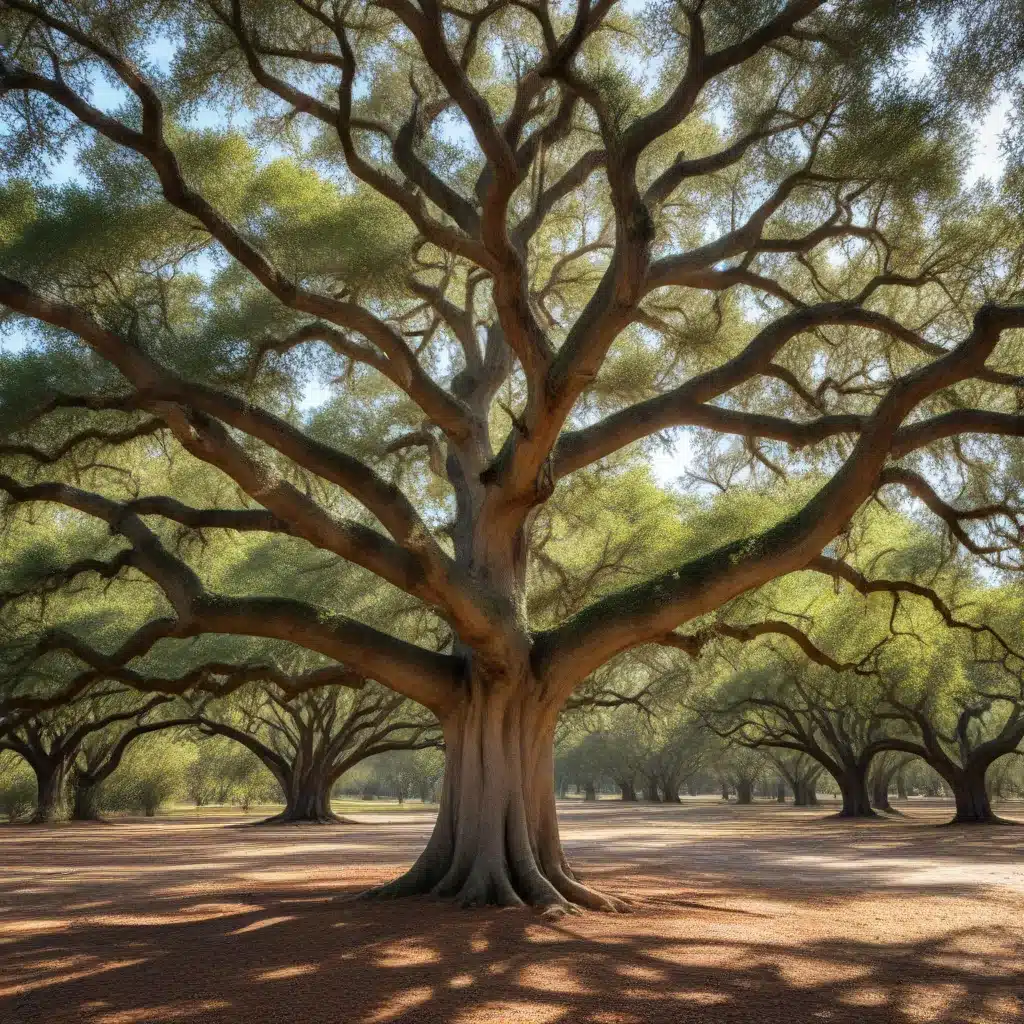
The live oak (Quercus virginiana), a magnificent member of the oak family (Fagaceae), is a captivating evergreen tree that has long been revered for its graceful, sprawling silhouette and profound cultural significance across the Southeastern United States. Adapted to the temperate coastal regions, this iconic species flourishes in the maritime environments of the Carolinas, Georgia, and Florida, where its broad, gnarled branches draped in wispy Spanish moss create a serene and timeless ambiance.
Botanical Classification and Morphology
Botanically classified within the Quercus genus, the live oak is a evergreen oak species, distinguished by its leathery, dark green leaves that persist year-round, unlike the deciduous oaks that shed their foliage seasonally. The live oak’s distinctive canopy is characterized by a broad, spreading habit and low-hanging, twisted branches that often reach towards the ground, creating a unique and captivating form.
The live oak’s thick, sturdy trunk and extensive, deep root system allow it to thrive in a variety of soil conditions, from the well-drained sands of coastal dunes to the heavy, clay-rich soils of inland areas. This remarkable adaptability has enabled the live oak to become a dominant feature in the landscapes of the Southeastern United States, where it has coexisted with human settlements for centuries.
Habitat and Distribution
The live oak is native to the Southeastern United States, with a natural range extending from coastal Virginia down through Texas and as far west as Mexico. These majestic trees are particularly well-suited to the temperate, humid climate and saline environments of the coastal regions, where they play a vital role in stabilizing the soil and mitigating coastal erosion.
The live oak’s tolerance for salt and ability to thrive in sandy, well-drained soils have made it a beloved and iconic tree in the coastal communities of the Carolinas, Georgia, and Florida. In these areas, the live oak’s evergreen foliage and sprawling silhouette have become a defining characteristic of the region’s landscapes, gracing parks, historic sites, and residential neighborhoods with their timeless beauty.
Ecological Significance
The live oak’s ecological importance extends far beyond its aesthetic appeal, as this species plays a crucial role in the coastal ecosystems it inhabits. The live oak’s deep, extensive root system helps to stabilize the soil, mitigating coastal erosion and providing a vital habitat for a diverse array of plant and animal species.
The live oak’s broad, shading canopy offers shelter and nesting sites for a variety of birds, mammals, and insects, contributing to the overall biodiversity of the coastal regions. Additionally, the tree’s evergreen foliage provides a year-round source of food and refuge for local wildlife, making it an integral component of the region’s delicate ecological balance.
Cultural and Historical Significance
The live oak has long been revered by the Native American tribes that have inhabited the Southeastern United States for centuries. The Wee Nee, Pee Dee, Waccamaw, Winyah, and Santee tribes all recognized the live oak’s significance, incorporating it into their cultural traditions and using its wood for a variety of purposes, from construction to the creation of tools and weapons.
The live oak’s enduring presence in the region’s landscapes has also made it a source of inspiration for artists, writers, and historians, who have celebrated its timeless beauty and resilience in their works. From the evocative paintings of the Hudson River School to the poetic musings of Southern literary giants, the live oak has become a symbol of the South’s rich cultural heritage and the enduring connection between people and the natural world.
Landscape and Urban Applications
Given the live oak’s majestic stature, broad canopy, and tolerance for a variety of soil conditions, it has become a highly sought-after tree for use in both landscape and urban settings. In parks, gardens, and along city streets, the live oak’s towering presence and distinctive silhouette create a sense of timeless elegance and natural beauty, making it a popular choice for shade and ornamental plantings.
In coastal communities, the live oak’s salt tolerance and erosion-mitigating properties have made it an invaluable asset, as these trees help to stabilize the soil and protect against the effects of coastal erosion and storm surges. By strategically incorporating live oaks into their urban landscapes, these coastal towns and cities have not only enhanced the aesthetic appeal of their neighborhoods but also reinforced the natural defenses against the challenges posed by a changing climate.
Conservation and Preservation
Despite the live oak’s widespread popularity and ecological importance, the species faces a variety of threats, both natural and human-induced. Pests, diseases, and climate change can all pose significant challenges to the long-term health and survival of these majestic trees, underscoring the need for proactive conservation and preservation efforts.
In response, various organizations and local governments have implemented initiatives to protect and propagate the live oak, with a particular focus on safeguarding the region’s ancient, heritage trees. These efforts include the establishment of tree protection ordinances, the development of reforestation programs, and the promotion of sustainable landscape design practices that prioritize the preservation of existing live oak specimens.
By raising awareness of the live oak’s unique adaptations, ecological significance, and cultural value, these conservation initiatives aim to ensure that this iconic tree continues to grace the landscapes of the Southeastern United States for generations to come. As TriCounty Tree Care continues to champion the preservation of the region’s natural heritage, the live oak remains a testament to the enduring beauty and resilience of the natural world.


